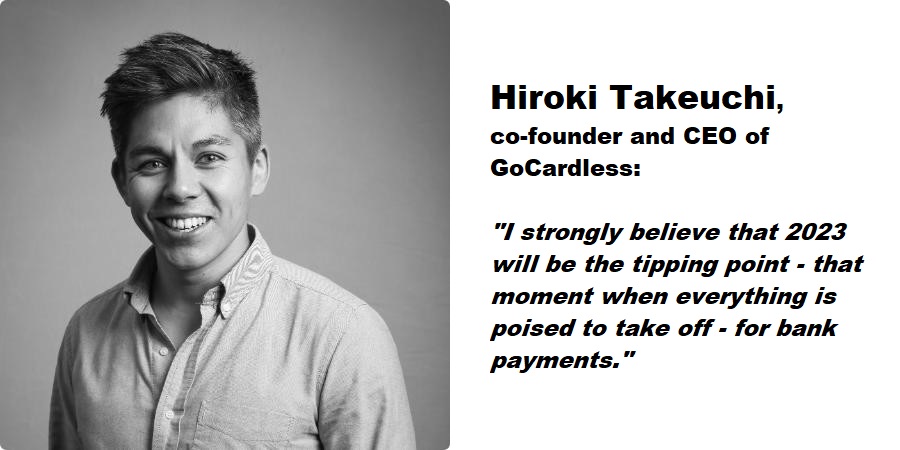
Three reasons why we expect to see ‘paying by bank’ becoming more popular next year. I strongly believe that 2023 will be the tipping point – that moment when everything is poised to take off – for bank payments.
an article written by Hiroki Takeuchi, co-founder and CEO of GoCardless
For the last few years, bank payments or account-to-account payments have been the realm of a few niche paytechs. And while certain markets such as the Netherlands, with its iDEAL system used for 60 per cent+ of online transactions, have seen bank payments go mainstream, in many markets the prevalence of cards, lack of technological advancement and slow buy-in from certain industry players, among other factors, have impeded mass adoption.
However, over the past 18 months, interest in paying by bank – and the infrastructure to support it – has grown. Here are three reasons why we believe 2023 will be the year of bank payments.
Bank payments are already on the rise
In the UK, bank payments have been around for decades: Direct Debit is already a trusted and very established form of payment. But newer rails that move money directly from one account to another are also gaining traction.
According to the latest Payments Market Report from UK Finance, Faster Payments volumes increased by 23 per cent year-on-year to reach 3.6 billion – and outnumbered the volume of credit card payments in 2021, at 3.4 billion. And with organisations like HMRC rapidly ramping up tax collection via open banking payments, doubling the amount taken through this method in just five months, plus new technology like Variable Recurring Payments coming online, it’s likely that many more of us will see bank payments crop up in our everyday lives.
That’s not to say ‘Faster Payments’ or ‘open banking’ will become part of our daily conversations, however. And actually, it doesn’t matter. The important bit is for everyone to start associating that ‘pay by bank’ button with faster, easier and more secure payments. This will build familiarity and goodwill which, in turn, will help all of us feel more comfortable choosing bank payments the next time they’re offered.
The true cost of cards is becoming apparent
2022 saw the Goliath v. Goliath battle of Amazon threatening to ban UK-issued Visa cards due to excessive fees. 2023 will see the fee fight escalate as politicians in the US attempt to wrangle The Credit Card Competition Act through Congress. The rising cost of doing business will also push merchants of all sizes in all markets to take a long, hard look at their expenses.
In the UK alone, card fees have increased over 13 per cent since 2015. Yet in many respects, the allure of accepting cards has decreased, with Strong Customer Authentication denting conversion rates and younger generations increasingly shying away from debt.
The true cost of cards, monetary and otherwise, will continue to be revealed in 2023. In this context, it’s no surprise that Forrester has predicted at least one global retailer will start experimenting with a ‘pay by bank’ mechanism, passing along the savings from card fees to its customers.
Incumbents are wading in and real-time payments are taking off
In November JPMorgan and MasterCard announced their Pay-by-Bank product, which they claim will ‘modernize account-based payments’. The move validates our hypothesis that the US market in particular, with its manual transfers and antiquated cheques, is ripe for disruption.
In the US we, like the two incumbents, are focusing on areas where bank payments are already common, such as utilities and property management. Not only will it be easier to convince businesses that already use ACH to upgrade to ‘ACH 2.0’, or a version built for the digital age – these verticals also represent the perfect beachhead from which to introduce consumers to bank payments.
After all, nearly everyone has to pay electricity bills. Once we experience the method through a ‘hero’ use case and see the benefits, we’ll become more open to trying it in another context. This will encourage mass adoption, akin to what Transport for London (TfL) did for contactless here in the UK.
There are two other ingredients to add to the mix: FedNow is due to launch in July and, over on our side of the pond, it seems likely that other banks will join household names like HSBC and Barclays in adding a ‘pay by bank’ option for their customers. All the pieces are coming together to accelerate the use of bank payments.
The article in full here
Banking 4.0 – „how was the experience for you”
„So many people are coming here to Bucharest, people that I see and interact on linkedin and now I get the change to meet them in person. It was like being to the Football World Cup but this was the World Cup on linkedin in payments and open banking.”
Many more interesting quotes in the video below: